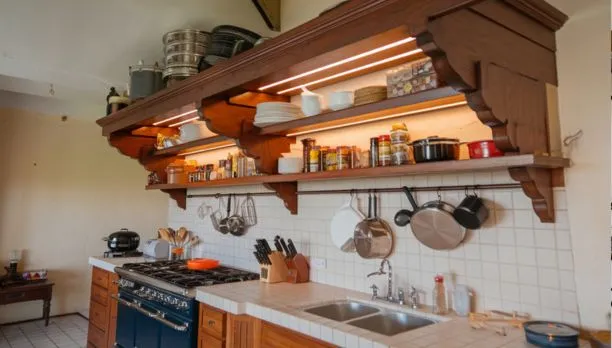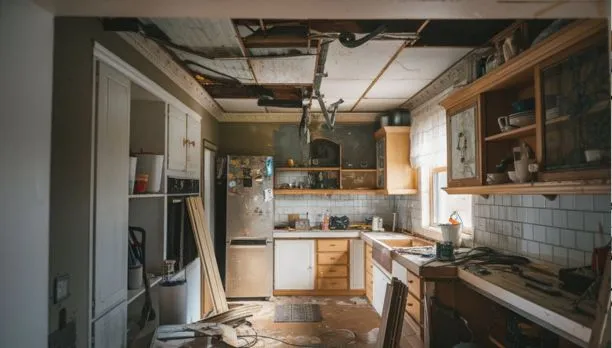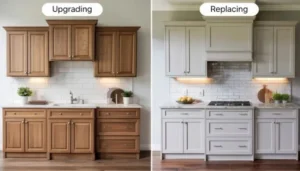Kitchen soffit removal is becoming a popular upgrade among homeowners looking to modernize their space. At Poseidon Remodeling, we understand that outdated soffits can make kitchens feel smaller and limit design possibilities. Originally built to conceal ductwork, wiring, or structural components, kitchen soffits were a common feature in older homes. However, with contemporary trends favoring open, airy spaces, many homeowners are opting to remove them for a sleeker look.
Before moving forward with kitchen soffit removal, it’s essential to evaluate your kitchen’s structure. Some soffits may house essential utilities, making removal more complex and costly. By assessing potential obstacles ahead of time, you can determine whether removal is the right choice for your renovation. Let’s explore the benefits, challenges, and key factors to consider before making a decision.
What is a Kitchen Soffit and Why Do Kitchens Have Them?

When planning a kitchen renovation, one of the biggest design decisions homeowners face is whether to keep or remove the kitchen soffit. At Poseidon Remodeling, we often get questions about whether kitchen soffit removal is necessary or beneficial. To make the right choice, it’s important to understand what a kitchen soffit is, why it was originally built, and how it affects your kitchen’s functionality.
The Purpose and History of Kitchen Soffits
Kitchen soffits were commonly installed in homes built during the mid-to-late 20th century. Their main purpose was to conceal essential systems such as electrical wiring, plumbing pipes, or HVAC ducts. In some cases, soffits were purely decorative, added to create a seamless transition between cabinets and the ceiling.
Older homes often had shorter cabinetry, leaving a gap between the top of the cabinets and the ceiling. Instead of leaving an empty space, builders installed soffits to cover it up and give the kitchen a more finished look. However, with modern design trends favoring taller cabinets and open spaces, many homeowners now see soffits as outdated and unnecessary.
Materials Used in Kitchen Soffits
The construction of a kitchen soffit varies depending on the home’s age and design. Common materials include:
- Drywall: The most frequently used material, attached to a wooden frame.
- Plywood: Some older homes feature plywood soffits, often covered in decorative trim.
- Plaster: In historic homes, plaster was used to create seamless soffits that blended with the ceiling.
- MDF or Particleboard: Lightweight and cost-effective, used in newer builds.
Understanding what your soffit is made of can help determine the complexity of kitchen soffit removal. If it’s simply drywall and framing, removal may be straightforward. However, if it’s hiding electrical or plumbing systems, modifications may be required.
How Kitchen Soffits Impact Design and Storage
A kitchen soffit significantly influences both aesthetics and storage capacity. Here’s how:
- Reduces Vertical Storage: Soffits limit the height of upper cabinets, preventing homeowners from maximizing storage space.
- Affects Lighting Placement: If a soffit extends across the kitchen, it can interfere with recessed lighting or pendant fixture placement.
- Closes Off the Space: Removing a soffit can make the kitchen feel taller and more open, enhancing the overall layout.
At Poseidon Remodeling, we always assess the structural purpose of a soffit before recommending removal. If it serves no functional need, removing it can create a more spacious and modern kitchen. However, if it houses essential utilities, adjustments may be necessary.
Pros of a Kitchen Soffit Removal

At Poseidon Remodeling, we’ve seen how kitchen soffit removal can completely transform a space. While soffits were once a standard feature in older homes, they often feel bulky and limit design possibilities. If you’re planning a kitchen remodel, removing the soffit kitchen feature can offer several benefits, from increasing storage to creating a more modern look. Let’s explore why removing a soffit can be a great decision for your renovation.
Creates a More Open and Spacious Kitchen
One of the biggest advantages of kitchen soffit removal is the impact it has on space. Soffits can make a kitchen feel closed in, especially in smaller layouts. By eliminating them, you instantly gain vertical space, making the room feel taller and more open. This is especially beneficial in homes with low ceilings, where every inch of extra height counts.
Allows Taller Cabinets and More Storage
A soffit kitchen design often limits the height of upper cabinets, reducing valuable storage space. When you remove the soffit, you can install taller cabinets that extend to the ceiling. This not only increases storage capacity but also eliminates that awkward gap above cabinets where dust and clutter tend to accumulate. More storage means better organization, making your kitchen more functional and efficient.
Provides Opportunities for Modern Design Upgrades
Today’s kitchen remodel trends focus on sleek, open, and efficient designs. Removing a soffit allows for more flexibility in choosing cabinetry styles, lighting, and decorative elements. You can incorporate glass-front cabinets, floating shelves, or custom-built storage solutions that wouldn’t be possible with a soffit in place. Additionally, removing soffits provides more room for stylish backsplashes and accent walls, enhancing the kitchen’s overall aesthetic.
Eliminates Outdated Soffit Aesthetics
A soffit kitchen design can make a space feel outdated, especially in homes with a more traditional layout. Removing the soffit instantly modernizes the kitchen, giving it a cleaner and more streamlined appearance. Without a soffit blocking the view, the kitchen feels more cohesive and contemporary, blending seamlessly with the rest of the home.
At Poseidon Remodeling, we specialize in transforming kitchens by maximizing space and improving functionality. If you’re considering kitchen soffit removal, our team can help assess whether it’s the right choice for your home and ensure a smooth remodeling process. Removing a soffit is more than just a cosmetic change; it’s a step toward a more spacious, efficient, and beautiful kitchen.
Cons of a Kitchen Soffit Removal

While kitchen soffit removal can open up a space and modernize the look of your kitchen, it’s not always a simple process. At Poseidon Remodeling, we’ve encountered situations where homeowners are surprised by hidden obstacles behind their soffits. Before committing to this change, it’s important to understand the potential downsides, including unexpected structural challenges, added costs, and delays. Here are some of the key drawbacks to consider when removing a soffit in a kitchen.
Uncovering Unexpected Obstacles (Wiring, Ductwork, etc.)
Many homeowners assume that soffits are purely decorative, but they often hide essential utilities. Behind a soffit in a kitchen, you might find electrical wiring, plumbing pipes, HVAC ducts, or even structural support elements. If this is the case, you’ll need to reroute or relocate these systems, which can add to both the complexity and cost of your kitchen soffit removal. Without a proper inspection beforehand, you may face unexpected surprises that could disrupt your renovation timeline.
Higher Renovation Costs if Structural Changes Are Needed
Removing a soffit isn’t just about demolition it often involves modifications to the surrounding area. If a soffit houses important wiring or plumbing, you may need to hire additional professionals such as electricians or plumbers to make the necessary adjustments. In some cases, if the soffit was installed for structural reasons, reinforcing the area may be required. This can significantly increase the cost of your kitchen remodeling San Diego project.
Possible Need for Extensive Drywall or Ceiling Repairs
Once the soffit in a kitchen is removed, there may be visible gaps or damage to the ceiling and walls. Fixing these imperfections requires drywall patching, sanding, and painting to create a seamless finish. If the soffit was attached to the cabinets, you may also need to repair or replace parts of the cabinetry to ensure everything looks cohesive. These additional tasks can add both time and expense to the project.
Delays in the Remodeling Process Due to Extra Work
Since every kitchen is different, kitchen soffit removal can sometimes lead to unforeseen complications. If unexpected electrical or plumbing work is needed, it can delay the overall timeline of your kitchen remodeling San Diego project. Ordering new materials, scheduling contractors, and making design adjustments all take time, which could extend your renovation beyond the original estimate.
At Poseidon Remodeling, we always conduct a thorough assessment before removing a soffit in a kitchen to identify any potential obstacles. While soffit removal can enhance a kitchen’s design, it’s important to weigh the challenges against the benefits to make an informed decision. If you’re unsure whether removal is the right choice, our team can help you explore the best options for your kitchen renovation.
5 Essential Steps Before Deciding on Kitchen Soffit Removal
Removing a soffit can completely transform the look of your kitchen, but before you start tearing it down, there are important factors to consider. At Poseidon Remodeling, we help homeowners assess whether kitchen soffit removal is the right choice for their space. Some kitchens with soffits may have hidden complications that require extra planning and budgeting, especially when adjusting for standard kitchen cabinet sizes after removal. Follow these five key steps to ensure a smooth and successful remodel.
Step 1: Inspect the Soffit for Electrical, Plumbing, or Ductwork
- Before starting any demolition, check what’s inside the soffit.
- Some kitchens with soffits hide electrical wiring, plumbing pipes, or HVAC ductwork.
- If essential systems are inside, removal will require professional rerouting, adding to costs and time.
- A small inspection hole can help determine what’s behind the drywall before full removal.
Step 2: Get a Professional Assessment for Removal Feasibility
- Hiring a remodeling expert ensures you make an informed decision.
- A contractor can evaluate whether the soffit is purely decorative or has structural significance.
- At Poseidon Remodeling, we assess whether soffit removal will interfere with the stability of the ceiling or cabinets.
- A professional can also suggest alternative solutions if full removal isn’t possible.
Step 3: Set a Realistic Budget for Soffit Removal and Kitchen Updates
- Kitchen soffit removal costs vary depending on what’s inside the soffit and the repairs needed afterward.
- Budget for additional costs such as rerouting utilities, patching drywall, and repainting.
- Consider whether you’ll need new cabinetry after removal. When replacing cabinets, decide between kitchen cabinets framed vs frameless, as this choice impacts both cost and aesthetics.
- Having a clear budget ensures there are no surprises during the renovation.
Step 4: Explore Alternative Remodeling Options if Full Removal Isn’t Possible
- If the soffit houses essential wiring or ductwork, complete removal may not be practical.
- Consider modifying or disguising the soffit instead of removing it.
- Alternatives include building a decorative bulkhead, installing open shelving, or extending cabinets to blend with the soffit.
- Our team at Poseidon Remodeling can suggest creative ways to modernize kitchens with soffits without major structural changes.
Step 5: Plan for Design Adjustments Post-Soffit Removal
- Once the soffit is gone, your kitchen layout may need updates.
- Decide if you’ll replace the old cabinets with taller ones or opt for an open-shelf design.
- Consider ceiling repairs, lighting placement, and backsplash extensions to create a seamless look.
- Whether choosing kitchen cabinets framed vs frameless, your new setup should complement the overall kitchen aesthetic.
Should You Remove Your Kitchen Soffit?
Deciding whether to remove a kitchen soffit is a major consideration in any renovation. While many homeowners choose kitchen soffit removal to create a more open and modern space, it’s not always the best option for every kitchen. At Poseidon Remodeling, we help clients weigh the pros and cons based on their kitchen layout, budget, and overall design goals. Here’s how to determine if removing your kitchen soffit is the right decision for you.
When Kitchen Soffit Removal Makes Sense
Removing a kitchen soffit can be a great choice if:
- You want taller cabinets for more storage and a seamless look.
- The soffit is empty and serves no functional purpose.
- You’re planning a major renovation and can adjust utilities if needed.
- You prefer an open-concept kitchen with a more modern aesthetic.
- The soffit makes the kitchen feel smaller or outdated.
If your goal is to maximize storage, removing the soffit can allow for larger cabinets that reach the ceiling. However, it’s important to consider other renovation costs that may come with this change, such as the cost to replace kitchen countertops or update the backsplash to fit the new design.
When Keeping or Modifying the Soffit is a Better Option
In some cases, removing a kitchen soffit isn’t the best choice. You may want to keep or modify it if:
- The soffit houses important wiring, plumbing, or ductwork that would be expensive to reroute.
- The ceiling height is low, and removal wouldn’t create a noticeable difference.
- Your budget doesn’t allow for the extra work that soffit removal requires.
- You prefer to update the soffit’s look with decorative molding or built-in lighting instead of tearing it out.
If the cost to replace kitchen countertops or install new cabinets is already stretching your renovation budget, keeping the soffit and updating its appearance may be a smarter financial decision.
Professional Insights for a Well-Informed Decision
Before committing to kitchen soffit removal, consulting with a professional is essential. A contractor can:
- Inspect the soffit to determine if removal is feasible.
- Provide cost estimates for necessary modifications.
- Suggest alternative solutions if full removal isn’t ideal.
- Ensure a smooth transition between your ceiling, cabinets, and countertops after soffit removal.
At Poseidon Remodeling, we take a strategic approach to every kitchen remodel, helping homeowners decide whether removing or modifying a kitchen soffit is the best choice. If you’re considering soffit removal, reach out to our experts for a consultation and personalized recommendations.
Final Thought
Removing a kitchen soffit can significantly enhance your space by creating a more open and modern look, allowing for taller cabinets and improved storage. However, kitchen soffit removal isn’t always straightforward; it can reveal hidden wiring, plumbing, or ductwork that requires professional adjustments.
At Poseidon Remodeling, we help homeowners navigate the complexities of soffit removal to achieve a seamless and stylish kitchen transformation. Whether you’re planning a full remodel or exploring design alternatives, our team ensures quality workmanship and a hassle-free experience. Ready to upgrade your kitchen? Contact Poseidon Remodeling today for consultation and expert guidance!
FAQs
What is the purpose of a kitchen soffit, and why would I remove it?
A kitchen soffit is a box-like structure above cabinets that often hides wiring, plumbing, or ductwork. Many homeowners choose kitchen soffit removal to create a more open, modern look, allow for taller cabinets, and improve storage space.
What are the common challenges of kitchen soffit removal?
One of the biggest challenges of kitchen soffit removal is discovering hidden utilities like electrical wiring, pipes, or HVAC ducts. If these are present, professional modifications may be needed, which can add to the renovation cost and timeline.
Can I remove my kitchen soffit myself, or should I hire a professional?
If the soffit is purely decorative and doesn’t contain important utilities. However, if structural elements or electrical components are involved, hiring a professional like Poseidon Remodeling is the safest and most efficient option.
How much does it cost to remove a kitchen soffit?
The cost of kitchen soffit removal depends on factors like soffit size, hidden utilities, and required repairs. On average, costs can range from a few hundred to several thousand dollars, especially if rerouting plumbing or electrical work is necessary.
What should I do after removing my kitchen soffit?
After kitchen soffit removal, you may need to repair the ceiling and walls, update your lighting, or install taller cabinets for a seamless look. Poseidon Remodeling can help with post-removal design adjustments to ensure a beautifully finished kitchen.










